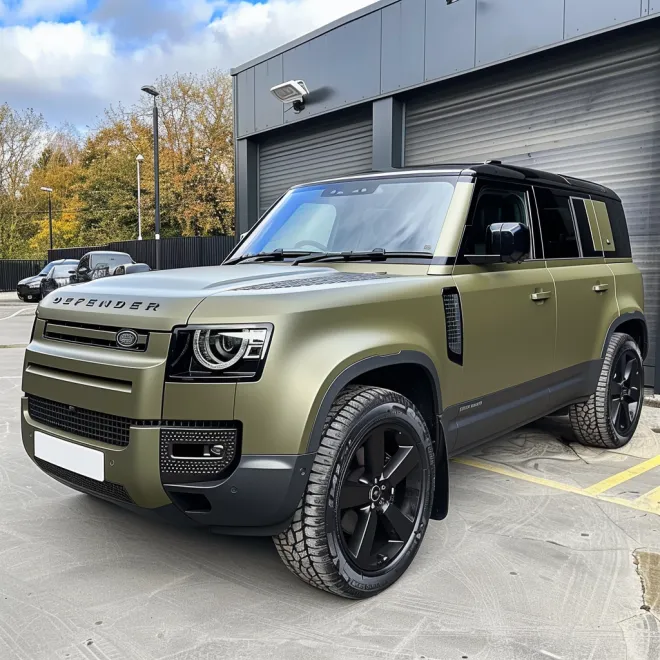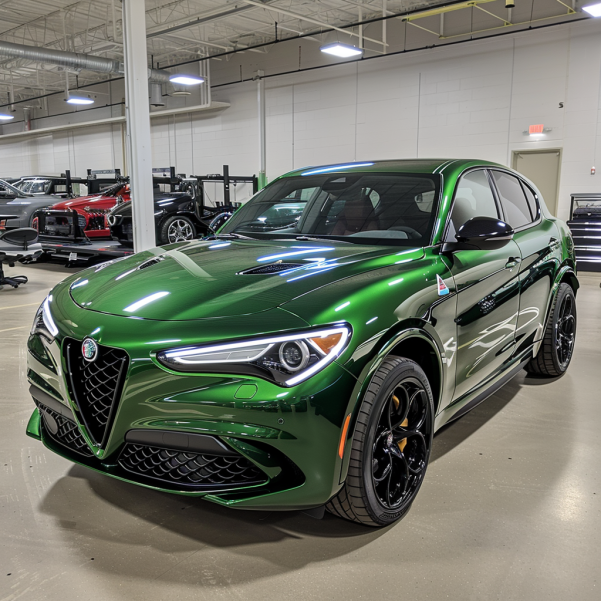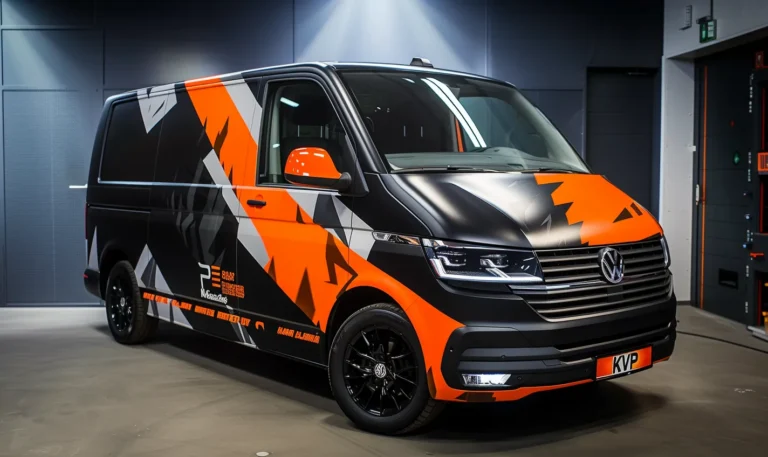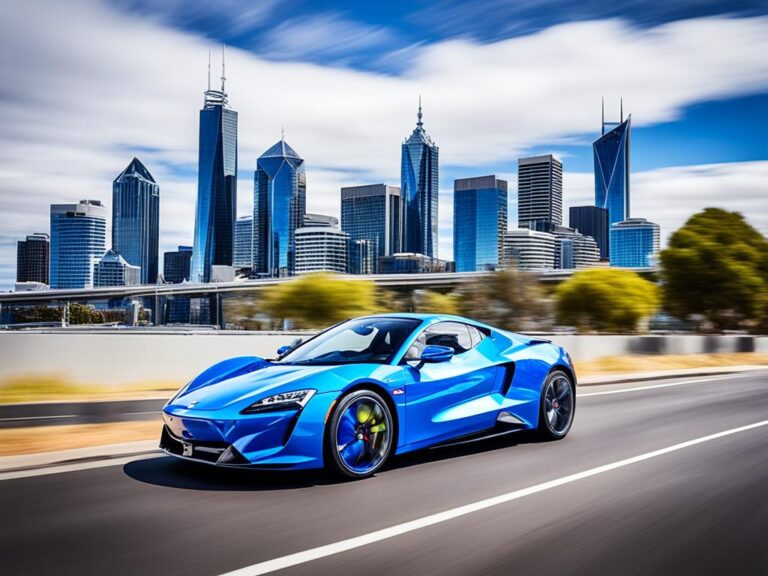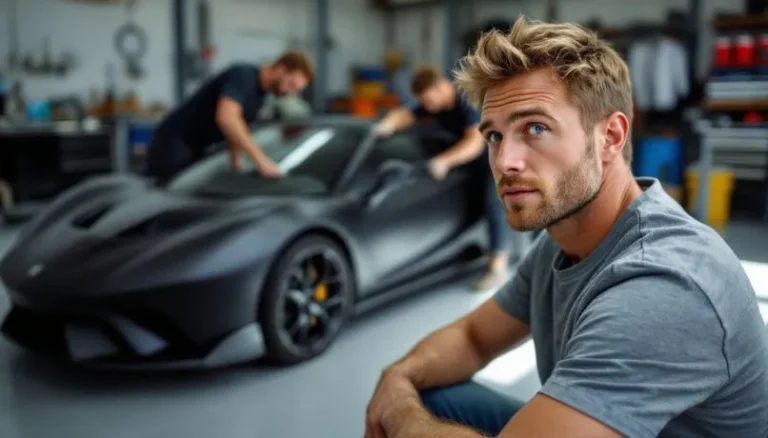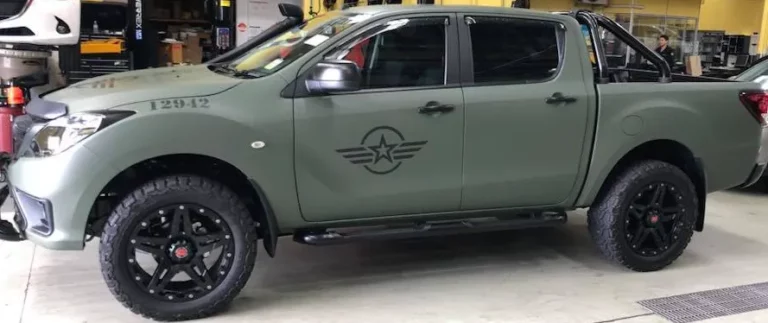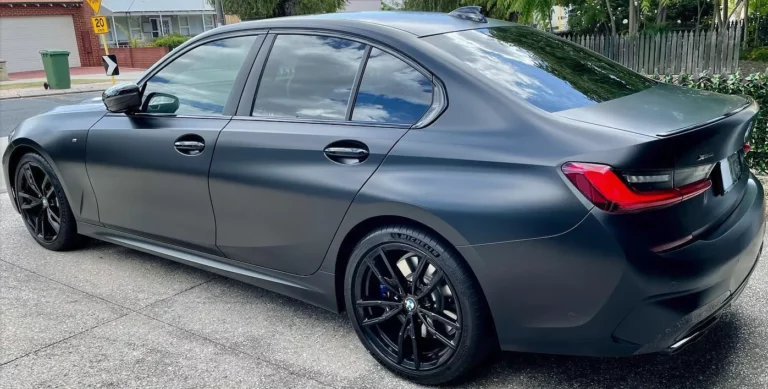Car Wrapping vs. Paint Protection Film (PPF):Which is Right?
Paint Protection Film (PPF) or Car Wrapping? Which is Right for You?

Car Wrapping Or Paint Protection Film (PPF) – Car wraps and Paint Protection Film (PPF) both shield your car’s paint. But they work in different ways. Car wrapping covers the entire vehicle with vinyl wrap, changing its colour or adding designs.
PPF is a clear film that protects from stone chips, UV rays, and road debris.
Car wrapping costs between £2000 to £6000 based on design and size. PPF can range from £750 to £8000 depending on the area covered and quality of film like Suntek or Xpel PPF. A wrap offers endless design choices but may not last as long as high-quality PPF which has self-healing properties for scratches and bird droppings damage…
This means fewer repairs!
Understanding Car Wrapping

Car wrapping covers your car’s paintwork with a thin vinyl film. You can change the colour, add graphics, or even give it a glossy finish. This method protects the original paint surface from scratches and chips.
The benefits include easy customisation and protection for your vehicle’s resale value. “It’s like giving your car a new outfit,” says one car enthusiast. But there are drawbacks too; wraps can fade or peel over time and may cost more than traditional paint jobs.
What is Car Wrapping?
Car wrapping covers a car with vinyl film to change its look or protect its paint. This wrap can be any colour or design you like. It also offers extra protection for the original car paint.
The best part? You can remove this wrap without hurting the car’s surface.
Professional installation ensures it looks good and lasts long. Car wrapping is usually cheaper than painting a whole car and takes less time to finish.
How Does Car Wrapping Work?
Car wrapping changes the look of your vehicle without repainting. It uses special vinyl films.
- Cleaning and Prep: The car must be very clean. This makes sure the wrap sticks well.
- Design Selection: Pick a colour or design. Many choices are available, like matte or gloss finishes.
- Measuring and Cutting: Measure all parts of the car. Cut the vinyl sheets to fit each part.
- Application of Vinyl Wrap: Start with one section at a time—like the bonnet or bumper. Use heat guns and squeegees to smooth out bubbles.
- Stretching and Wrapping Edges: Stretch the vinyl so it covers edges well. This avoids peeling later on.
- Trimming Excess Vinyl: Trim off any extra wrap carefully with a knife.
- Post Heating: Heat treat wrapped areas to make them stick better and finish smoothly.
Head over to “What Are the Benefits of Car Wrapping?” for more information!
What Are the Benefits of Car Wrapping?

Car wrapping has many useful benefits. It offers an easy way to change your car’s look without paint.
- Customisation: Choose any colour, design or pattern you like. There are endless wrap films options such as gloss or matte finishes.
- Protection: Wraps act as a protective layer on your car’s original paint. They protect from scratches, bug splatter and small dents.
- Cost-effective: Cheaper than a full repaint job. Costs depend on the size of the vehicle wrap.
- Reversible: Easy to remove if you want to go back to the original paint or try a new look.
- Durability: High-quality wraps can last up to 5-7 years with proper care. They also provide an additional layer of protection from UV rays.
- Maintenance: Easier to clean and maintain compared to traditional paint. No need for special cleaning products.
- Vehicle Resale Value: This helps maintain your vehicle’s resale value by protecting the original paint underneath.
- Quick Installation: Professional installers can apply a wrap in just a few days. Faster than waiting for layers of paint to dry.
Choosing car wrapping might be perfect if these benefits suit your needs!
What Are the Potential Drawbacks of Car Wrapping?
Car wrapping can be a great way to change your car’s look. But it has some downsides too.
- Less Protection – Car wrapping may not guard against stone chips and scratches like Paint Protection Film (PPF).
- Yellowing Over Time – Lower-grade vinyl wraps might turn yellow after some time and lose their shine.
- No Self-Healing – Vinyl wraps usually lack self-healing properties, making them prone to lasting damage if scratched.
- Shorter Lifespan – Vehicle wraps typically don’t last as long as high-quality PPF.
- Professional Installation Needed – Poor installation can lead to bubbles and wrinkles, which spoils the finish.
- Removal Risks – Taking off a vinyl wrap might harm the paint underneath if not done properly.
- Limited Customisation – Wraps offer fewer custom options compared to specific solutions with PPF.
These are some key points about car wrapping drawbacks.
Exploring Paint Protection Film (PPF)

Switching gears, let’s talk about Paint Protection Film (PPF). PPF offers nearly invisible defence against stone chips, UV rays, and road debris. It has self-healing properties to keep your car looking pristine.
High-quality options like SunTek PPF Ultra won’t yellow over time and come with a 10-year warranty. Professional PPF installation can increase your vehicle’s resale value by keeping the original paint intact.
It’s available in various choices—full or partial wraps—with different times needed for application.
If you want top-tier protection without changing the look of your car too much, opt for clear paint protection film. This automotive protective layer acts like ceramic coatings but adds an extra durable shield that protects from everyday hazards.
What is Paint Protection Film?

Exploring Paint Protection Film (PPF)
Paint Protection Film (PPF) is a clear adhesive coating. It helps shield your car paint from stone chips and UV rays. This protective film has self-healing properties, so small scratches fade away over time.
PPF also stops the paint from fading due to sun exposure.
High-quality PPF options like SunTek PPF Ultra offer long-term clarity and durability. They even come with anti-yellowing features to keep your car looking new. With choices for full or partial wraps, you can find a package that fits both your vehicle and budget needs.
How Does PPF Protect Your Vehicle?

PPF, or Paint Protection Film, is a great way to keep your car looking new. Here’s how it works:
- Stone chips – PPF shields your car from small rocks and stones that can chip the paint.
- UV rays – It blocks harmful UV rays, preventing paint from fading.
- Sea salt – The film guards against corrosive sea salt if you live near the ocean.
- Insects and road debris – It stops bugs and road junk from damaging your car’s surface.
- Self-healing properties – Small scratches on the film can heal themselves over time.
- Easier cleaning – Dirt and grime slide right off, making washing simple.
- Nearly invisible protection – High-quality PPF like 3M is clear and doesn’t change your car’s look.
- Enhances wraps – If you have a car wrap, PPF adds another layer of defence.
Using PPF can provide peace of mind, knowing your vehicle stays protected from everyday damage while looking its best.
What Are the Advantages of Using PPF?

Paint Protection Film (PPF) offers many benefits for your car. It keeps your vehicle looking great and helps it last longer.
- Invisible Protection: PPF is clear, so it doesn’t change the look of your car. It shields against stone chips, UV rays, and road debris.
- Self-Healing Properties: The film can heal itself from minor scratches. Small marks disappear with a bit of heat.
- Enhanced Surface Protection: It enhances existing wraps by adding an extra layer of defence. Your car paint stays perfect underneath.
- Customised Coverage: PPF is available in full or partial wraps. You choose which parts of your car need protection.
- Long Warranties: High-quality PPF usually comes with 5 to 10-year warranties. That’s long-lasting peace of mind.
- Easier Cleaning: Dirt and grime won’t stick as easily to PPF-covered surfaces. This makes washing your car simpler and quicker.
- Maintains Resale Value: Protecting the original paint helps keep the car’s value high. Buyers prefer cars without scratches and dings.
Using PPF is a smart choice for keeping your car in top shape!
Are There Any Limitations to Paint Protection Film?
Yes, Paint Protection Film (PPF) does have some limitations. It may not be perfect for every car owner.
- Cost: PPF can be pricey. High-quality paint protection film might cost more than $5,000 for a full wrap.
- Installation: Putting on PPF needs a pro hand. A bad job can leave bubbles or wrinkles.
- Colour Change: Clear PPF won’t change the car’s colour. If you want a new look, it won’t help.
- Yellowing: Over time, low-grade PPF can turn yellow in the sun.
- Edges and Seams: The edges of PPF might get dirty or start to peel after a while.
- Limited Self-Healing: Some PPF types can fix small scratches but not deep ones.
- Not Bulletproof: While it protects well, sharp rocks or large impacts can still damage your car’s paint.
- Maintenance: Regular care is needed to stay clear and protective, like cleaning with special products.
- Not Always Invisible: On close inspection, the film’s lines may be noticeable.
- Resale Issues: Future buyers might worry about what’s under the film or if its removal will damage the paint.
PPF: Key Differences
Let’s take a look at the key differences between Car Wrapping and Paint Protection Film (PPF).
| Aspect | Car Wrapping | Paint Protection Film (PPF) |
|---|---|---|
| Cost | Varies between $2,000 to $5,000 | Ranges from $750 to $10,000 |
| Aesthetic Appeal | Offers a wide range of colours and finishes | Clear and nearly invisible |
| Durability | Lasts 3-5 years | Lasts 5-10 years (with self-healing properties) |
| Removal | Relatively easy and leaves no residue | It can be customised for different vehicles and budgets |
| Protection | Provides minimal protection against scratches | Offers strong protection against chips, UV rays, and debris |
| Installation | Quick and less complex | Involves a thorough wash, inspection, professional application, and quality control checks |
| Warranty | Depends on the provider | Wrap Co offers a 5-10 year manufacturer’s warranty |
| Customisation | Highly customisable with various designs | Can be customised for different vehicles and budgets |
There you have it! The key differences between Car Wrapping and PPF. Each has its own perks and pitfalls.
How Do Costs Compare Between Car Wrapping and PPF?
Car wrapping and PPF have different costs. Car wraps can be cheaper, starting at around $2,000 for a full wrap. Paint Protection Film (PPF) costs more—between $750 to $8,000 depending on size and package choice.
Entry-level PPFs can start at $75 with basic protection.
High-end PPF options cost up to $190 with longer warranties. While wraps offer aesthetic upgrades, PPF protects against scratches and chips—a wise investment for long-term savings on repairs.
So, if you need strong car paint protection but have a higher budget…PPF might be best!
Which Option Offers Better Aesthetic Appeal?
PPF is nearly invisible and keeps your car looking new. It remains clear after installation, so the original look stays intact. PPF also has self-healing properties; small scratches vanish over time.
On the other hand, a wrap offers a variety of designs. You can change your car’s colour or add patterns and graphics easily. So, for those wanting creativity, wraps have more options—while PPF focuses on protection.
How Do Durability and Longevity Compare?
PPF offers warranties from 1 to 10 years, showing long-lasting durability. High-quality PPF, like SunTek PPF Ultra, has self-healing properties. This helps it last longer. Cheaper options may be yellow and wear out faster.
Vinyl wraps need more care than PPF. They generally last around 5-7 years if well-maintained. Both products can protect your car but in different ways. Proper installation of either is crucial for the best results.
Which Option is Easier to Remove or Change?
Car wraps are easy to remove. Use heat and peel them off. This process is quick, making car wraps a good choice for short-term changes or frequent updates. Car owners can change designs often without much hassle.
On the other hand, Paint Protection Film (PPF) also comes off with heat but needs a professional touch. PPF should be removed within 12 months after the warranty ends to prevent wear and tear.
Cheap PPF might lose self-healing properties, making removal tougher over time.
Factors to Consider When Choosing Between Car Wrapping and PPF
Consider your main goal. Do you want to change your car’s look? Car wrapping, also known as a “clear wrap,” offers many colours and styles. It is great for those who love custom designs.
Think about protection needs. Paint Protection Film (PPF) provides strong defence against scratches and swirl marks. Also, it has self-healing properties! This means small dents vanish over time.
What Are Your Primary Goals for Your Vehicle?
Choosing between car wrapping and PPF starts with knowing your primary goals for your vehicle. Protecting the paint is a big reason to pick these options. Do you want to keep your car’s original look? Paint protection film (PPF) can help by blocking damage from stones and road debris.
PPF also makes cleaning easier and keeps the car looking good for longer.
On the other hand, if you love custom designs, then car wrapping might be better. You can change colours or add styles that match your taste. Each option has benefits based on what you want most for your vehicle—protection or aesthetics!
How Important is Vehicle Aesthetics to You?
Vehicle aesthetics can boost your car’s resale value. A well-kept car looks appealing to buyers. Car wrapping offers many ways to change and enhance the look of your car. You get different colours, textures, and designs.
High-quality Paint Protection Film (PPF) keeps your vehicle looking fresh by shielding it from scratches and environmental damage. This keeps the original paint shiny and new. Opting for PPF or a wrap lets you express personal style while protecting the car’s appearance.
What Is Your Budget for Vehicle Customization?
Setting a budget for vehicle customisation is key. PPF pricing can range from $750 to $10,000, depending on the size of your car and the package you pick. Cheaper options may save money upfront but could lead to yellowing and less durability.
High-quality PPF films cost more but offer better transparency and longer life. Think about whether you want full or partial wraps. Your choice will fit your budget while still protecting your car’s paint.
How Much Protection Do You Need for Your Car?
Think about where you drive. City streets? Highways? Both have risks like stone chips and UV rays. Paint Protection Film (PPF) offers nearly invisible shielding against these dangers.
PPF can heal itself, thanks to its special properties. This helps it look good for a long time.
Your car type and budget matter, too. Options range from full wraps to just covering the front bumper or fender. High-quality PPFs like SunTek PPF Ultra give better protection with features like anti-yellowing and longer warranties.
Cheaper films might turn yellow faster and not last as long.
Are You Planning to Resell Your Vehicle Soon?
Consider how PPF can enhance your car’s resale value. It preserves the vehicle paint and keeps it looking new, which impresses buyers. The self-healing properties of advanced PPF mean fewer visible scratches.
Investing in high-quality PPF also cuts down on costly repairs. Buyers appreciate a well-kept car with a protected factory paint finish. Choose full or partial coverage based on your budget, ensuring you safeguard key areas that often get damaged.
High-end PPF even includes warranties from 1 to 10 years for peace of mind!
Conclusion: Which is Right for You?
Choosing between car wrapping and Paint Protection Film (PPF) boils down to your needs. Car wraps offer great style options. PPF, on the other hand, is best for protection. Think about what matters more to you—looks or durability? Talk with a pro installer to help decide.
How Do You Evaluate Your Options?
Think about what you want for your car. Need strong protection against stone chips and road debris? PPF wrap might be the best paint protection film for you. It has self-healing properties that keep your car looking new.
Companies like BUSHWRAPZ offer types of PPF with 5-10-year warranties.
If looks matter more, consider a full front or matte PPF wrap. Want to resell soon? A good paint correction can enhance resale value, as noted by TeckWrap. Check different customisation options and see which fits your budget best.
What Should You Discuss with a Professional Installer?
Discuss your specific needs for the finish type. Do you want a high gloss or matte look? Confirm the installation date to ensure timely service. Make sure they explain the types of films available, including warranties and how long they last.
Understand the installation process. Ask about preparation steps like washing and inspecting the vehicle. Inquire about customisation options for protecting key areas of your car. Seek clarification on maintenance tips to help PPF last longer.
How Can You Make an Informed Decision?
Check your goals for your car. Do you want nearly invisible protection? PPF is great against scratches, UV rays, and road debris. Think about its self-healing properties, too.
Look at the warranties offered by wrap companies, such as Wrap Co’s 5-10-year guarantee, which can help with resale value. Be careful of cheap alternatives; they might be yellow and not last long.
Ensure the installer prepares well and offers a satisfaction guarantee.
FAQs
1. What is the difference between car wrapping and Paint Protection Film (PPF)?
Car wrapping changes your car’s look with a new colour or design, while PPF protects the paint from damage. Car enthusiasts love both for different reasons.
2. How do I choose the best option for my specific vehicle?
Think about what you want – if you’re going to add style, go for car wrapping; if you need protection, opt for automotive paint protection film (PPF). It depends on your level of protection needs.
3. Does PPF have any special features?
Yes! The best PPF on the market often has self-healing properties and an optically clear coat that repels water and dirt. Your car stays looking like it’s fresh out of the showroom.
4. Can I fit these films myself?
You could try, but fitting into either film comes with its challenges! It’s usually better to get a professional to ensure it fits your car perfectly without bubbles or wrinkles.
5. Are there benefits of applying both methods together?
Absolutely! Combining a wrap with a PPF package gives you style and top-level protection all in one go – a great way to protect your investment while making it stand out.

